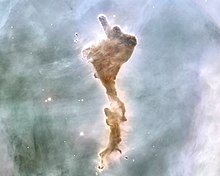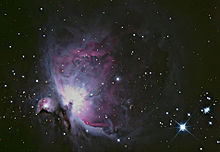Molecular cloud

Molecular clouds are interstellar gas clouds whose size, density and temperature allow the formation of molecules . Very dense and cold molecular clouds are known as dark clouds , they are the birthplaces of stars . More than half of the ( baryonic ) mass of the Milky Way is in the molecular clouds.
Types of molecules
The main component of such a cloud is molecular hydrogen (H 2 ), according to the abundance of the elements . However, this is very difficult to observe, which is why its frequency can often only be determined with the help of other molecules. One of the easiest molecules to observe is carbon monoxide (CO), the spectral lines of which can be detected with radio telescopes . However, the frequency of other molecules is at least 1000 times lower than the frequency of H 2 .
If the cloud is dense enough, many types of molecules can form, including complex amino acids . A certain density is necessary to protect the molecules from radiation, which would otherwise destroy the molecules again.
From the mid-1960s, radio telescopes were used to detect a large number of molecules in the interstellar medium , including the cyan (CN) and hydroxyl radicals (OH). These molecules emit radiation in the millimeter wavelength range. Over 150 different molecules have now been discovered in molecular clouds, such as B. water (H 2 O), hydrogen cyanide (HCN) or ethanol . Carbon monoxide is of particular importance for research into molecular clouds, because the mass of such a cloud can be determined based on the CO / H 2 ratio.
Giant Molecular Clouds

Very large molecular clouds are GMCs - (GMC Giant Molecular clouds called). The mass of these GMCs is around 10 4 -10 7 solar masses (M ☉ ), and they typically range from 50 to several hundred parsecs .
About 80% of the molecular hydrogen in the Milky Way is found in GMCs. The star formation in the Milky Way and neighboring galaxies is happening almost exclusively in GMCs. Initially, they only have average densities of around 10 −20 g / cm³, but in the course of star formation they condense by factors of around 10 18 to 10 20 . Most of the GMCs in our galaxy are in the spiral arms . It is assumed that there GMCs form due to gravitational instabilities from even larger molecular gas reservoirs, which are called GMA ( Giant Molecular Association ). Giant molecular clouds can also occur in gravitationally bound complexes, such as the Orion molecular cloud complex .
Partial areas of such a molecular cloud collapse due to their own gravity and so continuously form new stars, often in larger clusters .
Since we are looking directly into the galactic plane in our own galaxy and some of the GMCs (just in front of and behind the galactic center ) cannot be observed or their distance can be determined, one must fall back on observations of nearby galaxies for a better understanding of the GMCs.
Observations of GMCs in the Large Magellanic Cloud suggest a life cycle for GMCs (due to the distance and the lack of sensitivity to luminosity , only the formation of O stars can be observed):
- There is no star formation in the GMC during the first 6 million years after their formation.
- In the following 13 million years the first signs of the formation of stars can be found - H-II regions are formed.
- In the past 7 million years, star clusters with very young stars can be observed. The radiation field generated by these young stars destroys the entire GMC during this last phase.
While there is still no sign of massive star formation in the Large Magellanic Cloud and in M33 in around 25–33% of all GMCs , this occurs in almost all GMCs in the Milky Way.
See also
Individual evidence
- ↑ Kuan et al. (ApJ 593, 848, 2003).
- ↑ www.astrochemistry.net
- ^ Helmut Zimmermann and Alfred Weigert : ABC Lexicon Astronomy . Spectrum Academic Publishing House , Heidelberg 9 2000.
literature
- Fukui, Y. & Kawamura, A .: Molecular Clouds in Nearby Galaxies , Annual Review of Astronomy and Astrophysics , 2010, vol. 48, p. 547-580
- SW Stahler & F. Palla: The Formation of Stars. Chapter I / 3 Molecular Clouds , WILEY-VCH, Weinheim 2004, ISBN 3-527-40559-3
Web links
- Strange Molecular Cloud A dark heart pulsates in space. SPIEGEL online article about the Barnard 68 dark cloud .